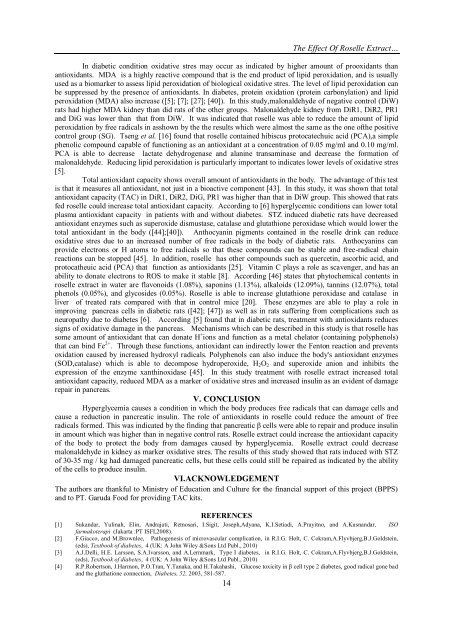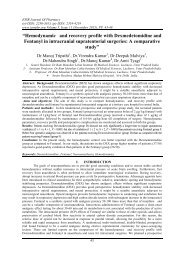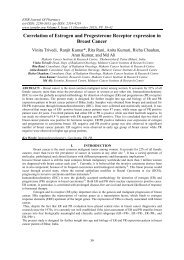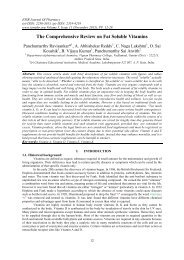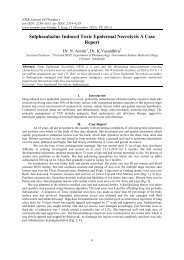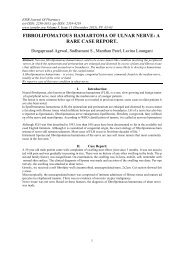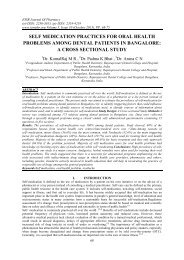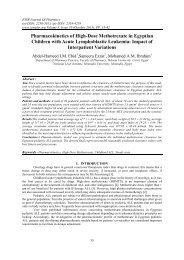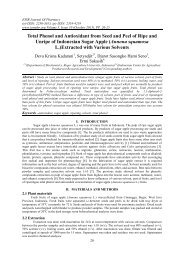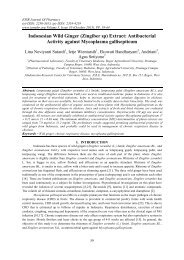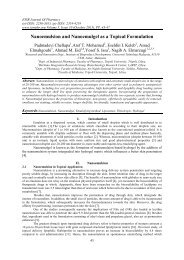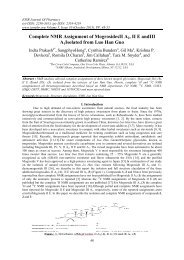The Effect Of Roselle Extract (Hibiscus Sabdariffa Linn.) On Blood Glucose Level And Total Antioxidant Level On Diabetic Rat Induced By Streptozotocin
Create successful ePaper yourself
Turn your PDF publications into a flip-book with our unique Google optimized e-Paper software.
14<br />
<strong>The</strong> <strong>Effect</strong> <strong>Of</strong> <strong>Roselle</strong> <strong>Extract</strong>…<br />
In diabetic condition oxidative stres may occur as indicated by higher amount of prooxidants than<br />
antioxidants. MDA is a highly reactive compound that is the end product of lipid peroxidation, and is usually<br />
used as a biomarker to assess lipid peroxidation of biological oxidative stres. <strong>The</strong> level of lipid peroxidation can<br />
be suppressed by the presence of antioxidants. In diabetes, protein oxidation (protein carbonylation) and lipid<br />
peroxidation (MDA) also increase ([5]; [7]; [27]; [40]). In this study,malonaldehyde of negative control (DiW)<br />
rats had higher MDA kidney than did rats of the other groups. Malonaldehyde kidney from DiR1, DiR2, PR1<br />
and DiG was lower than that from DiW. It was indicated that roselle was able to reduce the amount of lipid<br />
peroxidation by free radicals in asshown by the the results which were almost the same as the one ofthe positive<br />
control group (SG). Tseng et al. [16] found that roselle contained hibiscus protocatechuic acid (PCA),a simple<br />
phenolic compound capable of functioning as an antioxidant at a concentration of 0.05 mg/ml and 0.10 mg/ml.<br />
PCA is able to decrease lactate dehydrogenase and alanine transaminase and decrease the formation of<br />
malonaldehyde. Reducing lipid peroxidation is particularly important to indicates lower levels of oxidative stres<br />
[5].<br />
<strong>Total</strong> antioxidant capacity shows overall amount of antioxidants in the body. <strong>The</strong> advantage of this test<br />
is that it measures all antioxidant, not just in a bioactive component [43]. In this study, it was shown that total<br />
antioxidant capacity (TAC) in DiR1, DiR2, DiG, PR1 was higher than that in DiW group. This showed that rats<br />
fed roselle could increase total antioxidant capacity. According to [6] hyperglycemic conditions can lower total<br />
plasma antioxidant capacity in patients with and without diabetes. STZ induced diabetic rats have decreased<br />
antioxidant enzymes such as superoxide dismustase, catalase and glutathione peroxidase which would lower the<br />
total antioxidant in the body ([44];[40]). Anthocyanin pigments contained in the roselle drink can reduce<br />
oxidative stres due to an increased number of free radicals in the body of diabetic rats. Anthocyanins can<br />
provide electrons or H atoms to free radicals so that these compounds can be stable and free-radical chain<br />
reactions can be stopped [45]. In addition, roselle has other compounds such as quercetin, ascorbic acid, and<br />
protocatheuic acid (PCA) that function as antioxidants [25]. Vitamin C plays a role as scavenger, and has an<br />
ability to donate electrons to ROS to make it stable [8]. According [46] states that phytochemical contents in<br />
roselle extract in water are flavonoids (1.08%), saponins (1.13%), alkaloids (12.09%), tannins (12.07%), total<br />
phenols (0.05%), and glycosides (0.05%). <strong>Roselle</strong> is able to increase glutathione peroxidase and catalase in<br />
liver of treated rats compared with that in control mice [20]. <strong>The</strong>se enzymes are able to play a role in<br />
improving pancreas cells in diabetic rats ([42]; [47]) as well as in rats suffering from complications such as<br />
neuropathy due to diabetes [6]. According [5] found that in diabetic rats, treatment with antioxidants reduces<br />
signs of oxidative damage in the pancreas. Mechanisms which can be described in this study is that roselle has<br />
some amount of antioxidant that can donate H + ions and function as a metal chelator (containing polyphenols)<br />
that can bind Fe 2+ . Through these functions, antioxidant can indirectly lower the Fenton reaction and prevents<br />
oxidation caused by increased hydroxyl radicals. Polyphenols can also induce the body's antioxidant enzymes<br />
(SOD,catalase) which is able to decompose hydroperoxide, H 2 O 2 and superoxide anion and inhibits the<br />
expression of the enzyme xanthinoxidase [45]. In this study treatment with roselle extract increased total<br />
antioxidant capacity, reduced MDA as a marker of oxidative stres and increased insulin as an evident of damage<br />
repair in pancreas.<br />
V. CONCLUSION<br />
Hyperglycemia causes a condition in which the body produces free radicals that can damage cells and<br />
cause a reduction in pancreatic insulin. <strong>The</strong> role of antioxidants in roselle could reduce the amount of free<br />
radicals formed. This was indicated by the finding that pancreatic β cells were able to repair and produce insulin<br />
in amount which was higher than in negative control rats. <strong>Roselle</strong> extract could increase the antioxidant capacity<br />
of the body to protect the body from damages caused by hyperglycemia. <strong>Roselle</strong> extract could decrease<br />
malonaldehyde in kidney as marker oxidative stres. <strong>The</strong> results of this study showed that rats induced with STZ<br />
of 30-35 mg / kg had damaged pancreatic cells, but these cells could still be repaired as indicated by the ability<br />
of the cells to produce insulin.<br />
VI.ACKNOWLEDGEMENT<br />
<strong>The</strong> authors are thankful to Ministry of Education and Culture for the financial support of this project (BPPS)<br />
and to PT. Garuda Food for providing TAC kits.<br />
REFERENCES<br />
[1] Sukandar, Yulinah, Elin, <strong>And</strong>rajati, Retnosari, I.Sigit, Joseph,Adyana, K.I.Setiadi, A.Prayitno, and A.Kusnandar, ISO<br />
farmakoterapi (Jakarta :PT ISFI,2008).<br />
[2] F.Giacco, and M.Brownlee, Pathogenesis of microvascular complication, in R.I.G. Holt, C. Cokram,A.Flyvbjerg,B.J.Goldstein,<br />
(eds), Textbook of diabetes, 4 (UK: A John Wiley &Sons Ltd Publ., 2010)<br />
[3] A.J.Delli, H.E. Larsson, S.A.Ivarsson, and A.Lernmark, Type I diabetes, in R.I.G. Holt, C. Cokram,A.Flyvbjerg,B.J.Goldstein,<br />
(eds), Textbook of diabetes, 4 (UK: A John Wiley &Sons Ltd Publ., 2010)<br />
[4] R.P.Robertson, J.Harmon, P.O.Tran, Y.Tanaka, and H.Takahashi, <strong>Glucose</strong> toxicity in β cell type 2 diabetes, good radical gone bad<br />
and the gluthatione connection, Diabetes, 52, 2003, 581-587.


